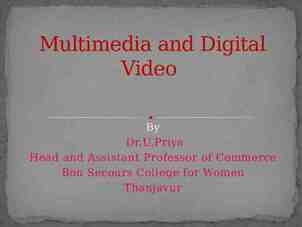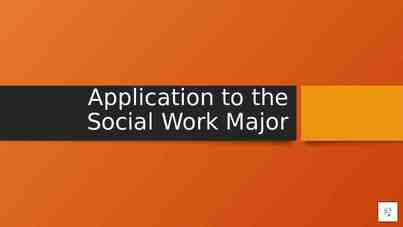AdvancED Continuous Improvement System
77 Slides6.85 MB

AdvancED Continuous Improvement System

Introduction: Why Continuous Improvement and why now?

The Perfect Storm Updated AdvancED Standards, Content & Protocol Updates Improved Technologies: eProve School Improvement New Law: ESSA (Increased Flexibility & Ownership) 3 New State Level Leadership & Direction 2017 AdvancED

Why Now? AdvancED Process and Commitment – Align With the Latest Research & Best Practice – Continuously Raise the Bar – Support a Continuous Improvement Journey – Address Feedback From the Field Every Student Succeeds Act (ESSA) 4 2017 AdvancED

Improvement Journey Education is a collection of moments that serve as guide posts in an ongoing journey. 5 5 Journey vs. Event Improvement vs. Compliance Our goal is to meet every educational organization where they are and empower them to successfully navigate a continuous improvement journey that is guided by a community inspired vision – to create a world of opportunities for every learner. 2017 AdvancED

Elements of the Improvement Journey

Current New Conduct an Internal Review Administer Parent, Student, & Staff Surveys Complete the Stakeholder Feedback Diagnostic Compile a student performance data document and complete the Student Performance Diagnostic Rate your school’s performance against the AdvancED Standards for Quality Schools using the Self Assessment Complete an Executive Summary Respond to a set of required Assurances Share evidence and information with AdvancED prior to the Engagement Review (3-4 weeks) that speaks to your school’s demonstrated commitment to quality and continuous improvement. Results of your school’s selfassessment against research-based factors of school quality Supporting evidence & information, such as: Submit Interview Review Results/Report, along with supporting evidence and information to AdvancED at least 6-8 weeks prior to scheduled External Review. 2017 AdvancED – – – – – Stakeholder (parents, students & staff) perceptions/options with regards to school climate & culture Stakeholder (students and teachers) data with regards to their experiences at the school Classroom observation results focused on student engagement in the learning environment Learner outcomes and the impact of instruction Adherence to AdvancED Accreditation Policies & Procedures (Assurances)

New – Recommended Tools Current – Required Tools Surveys Surveys (beliefs/opinions/perceptions) Parent Survey Staff Survey Student Survey (Middle and High) Student Survey (Elementary) Student Survey (Early Elementary) Diagnostics Stakeholder Feedback Diagnostic Student Performance Diagnostic Self Assessment Executive Summary Assurances Assurances Climate & Culture Parent Survey Climate & Culture Staff Survey Climate & Culture Teacher Survey Climate & Culture Middle/High Student Survey Climate & Culture Elementary Student Survey Staff Survey for Early Learning Schools Parent Survey for Early Learning Schools Inventories (experiences) Teacher Inventory Elementary/Middle School Student Inventory High School Student Inventory Impact of Instruction Inventory (coming soon) Observations eleot Diagnostics School Quality Factors Diagnostic Systems Quality Factors Diagnostic Early Learning Self Assessment Assurances Assurances (required) 2017 AdvancED

AdvancED Performance Standards School Systems standards are aligned with School standards Standards are rated by the Engagement Review Team using quantifiable questions and observations Focused and guided by domains, standards and concepts 9 2017 AdvancED

Resources www.advanc-ed.org/resources www.advanc-ed.org/schoolresources www.advanc-ed.org/systemsresource s 10 2017 AdvancED

Research-based Framework School Quality Factors Performance Standards Clear Direction Leadership Capacity Healthy Culture Learning Capacity High Expectations Resource Capacity Impact of Instruction Resource Management Efficacy of Engagement Implementation Capacity 3 Domains 30 School Standards 31 Systems Standards 34 Virtual/Digital Learning School Standards Separate but aligned institution (internal) and review team (external) tools and resources 2017 AdvancED

NEW Performance Standards (Schools) 3 Domains 30 Standards CURRENT 5 Standards 32 Indicators 12 Leadership Capacity Learning Capacity Standard 3: Teaching and Assessing for Learning Standard 1: Purpose and Direction Standard 5: Using Results for Continuous Improvement Standard 2: Governance and Leadership 2017 AdvancED Resource Capacity Standard 4: Resources and Support Systems

Standard Concepts Concept 1 Enga y b m a d e e T s U w e i v e tR n e m ge 2017 AdvancED Concept 2

AdvancED Continuous Improvement System Elements of the Journey – LEARN AND SHARE community of stakeholders share perspectives and experiences and learn about how the work of the school impacts every stakeholder, espeically students – EXAMINE AND PLAN critical self-analysis whereby the school community examines the work of the school against researchbased factors. Engaging stakeholders in defining the vision for the school as well as setting the strategic direction to achieve the vision. – ACT AND EVALUATE plot journey and take action. Gather evidence and determine results. Based on the results determine next steps to advance the journey. 14 2017 AdvancED Learn and Share Examine and Plan Act and Evaluate

Accreditation – Improvement Journey Collect and analyze data, prioritize improvement areas, define vision & set the strategic direction Plot journey, take action, gather evidence, evaluate results and continuously monitor and adjust Examine & Plan Act & Evaluate Meaningful Stakeholder Engagement- Collection and Analysis of Data About Stakeholder Perspectives and Experiences Climate & Culture Surveys Student Engagement Survey Student & Teacher Inventories Classroom Observations Internal Examination of School/System Quality Using Key Performance & Improvement Indicators Diagnostic Tools Learner Outcomes Strategy Map - Long-term Goals & Key Metrics Map an improvement journey and continuously assess progress Annual Improvement Plan Evidence-based Strategies Monitoring & Oversight Share Information & Evidence AdvancED Engagement Review (External Review) Elevates & focuses the journey through externally validated data, expertise, evaluation, support services and accountability. Evidence Examination Stakeholder Interviews Expert Evaluation Classroom Observations Prioritized Areas In Need of Improvement Standards Diagnostic Benchmarking Against the AdvancED Network 2017 AdvancED Accreditation Learn & Share of Quality Quality Distinction of Recognized Distinction Internationally Internationally Recognized research-based and research-based improvement and to continuous continuous improvement commitment to Demonstrated Demonstrated commitment standards. performance performance standards Gather and share perspectives and experiences across all stakeholder groups

Learn and Share: What?

AdvancED Continuous Improvement System Elements of the Journey – LEARN AND SHARE community of stakeholders share perspectives and experiences and learn about how the work of the school impacts every stakeholder, espeically students – EXAMINE AND PLAN critical self-analysis whereby the school community examines the work of the school against researchbased factors. Engaging stakeholders in defining the vision for the school as well as setting the strategic direction to achieve the vision. – ACT AND EVALUATE plot journey and take action. Gather evidence and determine results. Based on the results determine next steps to advance the journey. 17 2017 AdvancED Learn and Share Examine and Plan Act and Evaluate

Improvement Journey: Learn & Share Gather and share perspectives and experiences across all stakeholder groups Learn & Share Surveys (Perspectives) Climate & Culture Students (3-12) Teachers Staff Parents Student Engagement Inventories (Experiences & Actions) 18 Elementary/Middle School Students High School Students Teachers Elevate the importance of stakeholder engagement Bring voice to the entire community of stakeholders Broaden understanding through experience & perspectives Inform, Shape & Traverse the Journey Communicate & demonstrate commitment to a continuous improvement journey Frequency & type of data collection Actionable data 2017 AdvancED

Perspectives of key stakeholder groups on climate, culture, leadership, engagement 2017 AdvancED

Perspectives Surveys Culture/Climate (new) Student Engagement (new) Purpose Capture the overall culture of the institution through the lens of eight important areas: Taken by – – – – Students (Grades 3 -12) Teachers Staff Parents Expectations Actions Language Use of time Modeling Routines Interactions Environment PERSPECTIVES 20 2017 AdvancED

Climate & Culture Surveys Ex a m p les Stakeholders Students (3-12) Teachers Staff Parents Key Concepts: 21 Expectations Language Use of time Modeling Actions Routines Interactions Environment 2017 AdvancED

Surveys Over 25 surveys available in eProve surveys PERSPECTIVES 22 2017 AdvancED

Student Engagement Survey Collects direct feedback from students regarding their level and quality of engagement in the learning process. 2017 AdvancED

Student Engagement Survey Ex a m p les Grades 5-12 29 items aligned with 7 key learning environments Equitable Learning High Expectations Supportive Learning Active Learning Progress Monitoring and Feedback Well-Managed Learning Digital Learning Student experience in a given classroom 24 2017 AdvancED

Type of Engagement Cognitive Engagement – Includes a student’s perceptions and beliefs associated with school and learning. It refers to the cognitive processing a student brings to academic tasks as well as the amount and type of strategies a student utilizes (Walker, Greene, & Mancell, 2006. Identification with academics, intrinsic/extrinsic motivation, and selfefficacy as predictors of cognitive engagement.) Behavioral Engagement – Student’s observable actions or participation while at school that is investigated through a student’s positive conduct, effort, and participation (e.g., participation in extracurricular activities, attendance, and work habits.) (Fredricks, Blumenfeld, & Paris, 2004. School engagement: Potential of the concept, state of the evidence.) Affective Engagement – A student’s feelings toward his school, learning, teachers, and peers (Jimerson , Campos, & Grief, 2003. Toward an understanding of definitions and measures of school engagement and related terms.) 2017 AdvancED

Quality of Engagement Committed (Authentic Engagement) – The student volunteers resources under his/her control (time, effort and attention.) The student is attentive to the task because he/she find personal meaning and value in the task. The student persists with the task even when he/she experiences difficulty and does not compromise personal standards for the completion of the task. (Schlechty Center for Leadership in School Reform) Compliant – The student spends only as much time, energy and resources as are required to get the reward offered or designed. The student is attentive to the task because he/she perceives the receipt of some desired extrinsic reward which is conditionally available to those who pay attention to the task and do what is required of them. OR the student does only those things that must be done and does little or nothing outside the context of direct supervision by the teacher. (Schlechty Center for Leadership in School Reform) Disengaged – the student does nothing and when forced through direct supervision to do the task, either engages in compliance or rebellion. The student employs strategies to conceal his/her lack of involvement. Or the student overtly refuses to comply with the requirement of the task. (e.g., cheating, refusing to do the work, or even doing other work in place of what is expected.) (Schlechty Center for Leadership in School Reform) 2017 AdvancED

Student Engagement Survey Reporting for improvement & accountability Committed Compliant Disengaged Cognitive Engagement 22% 45% 33% Behavioral Engagement 5% 75% 20% Affective Engagement 14% 30% 56% OVERALL 14% 50% 36% 2017 AdvancED

Improving Student Engagement eleot Student Engagement Survey Learning Environments Equitable Learning High Expectations Supportive Learning Powerful and Actionable Data Progress Monitoring & Feedback Well-Managed Learning 2017 AdvancED

Experiences shared by students, parents, teachers. 2017 AdvancED

Experiences Student Inventory Inventories Purpose Types of Inventories Provide opportunity to voice relevant experiences Indicate frequency of experiences 30 Elementary Middle School High School Teacher EXPERIENCES 2017 AdvancED

Teacher Inventory Examp les 31 2017 AdvancED

Examine and Plan: So what?

AdvancED Continuous Improvement System Elements of the Journey – LEARN AND SHARE community of stakeholders share perspectives and experiences and learn about how the work of the school impacts every stakeholder, espeically students – EXAMINE AND PLAN critical self-analysis whereby the school community examines the work of the school against researchbased factors. Engaging stakeholders in defining the vision for the school as well as setting the strategic direction to achieve the vision. – ACT AND EVALUATE plot journey and take action. Gather evidence and determine results. Based on the results determine next steps to advance the journey. 33 2017 AdvancED Learn and Share Examine and Plan Act and Evaluate

Improvement Journey: Examine & Plan Collect and analyze data, prioritize improvement areas, define vision & set the strategic direction Examine & Plan Diagnostics School Quality Factors (SQF) Impact of Instruction Strategies Strategy Map 34 Determine and communicate a desired destination and key drivers Vision Mission Values Identify primary objectives in pursuit of that vision and mission 2017 AdvancED

Improvement Journey: Examine & Plan Collect and analyze data, prioritize improvement areas, define vision & set the strategic direction Examine & Plan Diagnostics School Quality Factors (SQF) Impact of Instruction Strategies Strategy Map 35 Analyze & consider conditions that impact the institution quality Collect & examine evidence that reflect the work of the institution Communicate what is learned to the community Establish, with stakeholders, a clear vision to guide the journey Define key strategic goals 2017 AdvancED

SQF Diagnostic Rating Scale vs. Rubric – Evidence Strongly Strongly Disagree Disagree Disagree Disagree Agree Agree Strongly Strongly Agree Agree Level Level of of Embeddedness Embeddedness in in the the Institution's Institution's Culture Culture oo oo oo oo Firmly Firmly Embedded Embedded Frequent Frequent Practice Practice Intermittent Intermittent Sporadic Sporadic Stage Stage of of Implementation Implementation School Quality Factors 36 Agreement oo oo oo oo Self-Assessment Sam pl e Sca les Agreement oo oo oo oo Clear Direction Healthy Culture High Expectations Impact of Instruction Resource Management Efficacy of Engagement Implementation Capacity Fully Fully Implemented Implemented Mostly Mostly Implemented Implemented Partially Partially Implemented Implemented Not Not Yet Yet or or Preparing Preparing for for Implementation Implementation Frequency Frequency Time Time oo oo oo oo 2017 AdvancED Always Always Often Often Sometimes Sometimes Seldom Seldom

SQF Diagnostic 37 2017 AdvancED Sample Items

School Quality Factors Factor Descriptor 38 Clear Direction The capacity to agree upon, define and clearly communicate to stakeholders the direction, mission and goals that the institution is committed to achieving. Healthy Culture The shared values, beliefs, written and unwritten rules, assumptions and behavior of stakeholders within the school community that shape the school's social norms and create opportunities for everyone to be successful. High Expectations A school’s stated commitment and demonstrated actions in service to high expectations for all stakeholders, including excellent student learning outcomes and success, high levels of teacher quality and support, leadership effectiveness, proactive community engagement, and authentic parent involvement. Impact of Instruction The capacity of every teacher to purposefully and intentionally create an environment that empowers all student to be successful in their learning and reach expected levels of achievement including readiness to transition to the next level of learning or career pathway. Resource Management The ability of a school to plan, secure, and allocate its resources (human, material, and physical) to meet the needs of every learner. Efficacy of Engagement The capacity to engage learners and other stakeholders in an effective manner to improve learning outcomes. Implementation Capacity The ability of a school to execute, with consistency, actions designed to improve organizational and instructional effectiveness. 2017 AdvancED

39 2017 AdvancED

SQF Practices EXAMPL E IMPACT OF INSTRUCTION The capacity of every teacher to purposefully and intentionally create an environment that empowers all learners to be successful and reach expected levels of achievement, including readiness to transition to the next level of learning or career pathway. Learners monitor their progress and are supported when they are not meeting expectations. Learners demonstrate success in achieving challenging goals. Instructional Staff monitor and evaluate impact of instruction on learner engagement, outcomes and overall success. Instructional Staff demonstrate the impact of their instruction through formative, summative and/or other outcome data. Leadership monitor and evaluate impact of instruction on learner engagement, outcomes and overall success. Other Staff implement actions that support teaching, learning and overall learner success. Parents and families connect their children’s school experiences with engagement, outcomes and overall learner success. Community perception of the institution’s quality of teaching and learning is positive. 40 2017 AdvancED

Impact of Instruction Diagnostic Teacher reported student outcome data Combination of performance and growth results Data types being considered – – – – 41 Numeric Letter Binary Other (locally defined) 2017 AdvancED er d n t! U n e m p o l e Dev

SQF Planning Tool Using the SQF Planning Tool and the SQF, fill in the five columns for each Factor. 42 2017 AdvancED

2017 AdvancED

2017 AdvancED

Quality Evidence Using the Quality Evidence Activity, select two factors and list possible examples of quality evidence. 45 2017 AdvancED

Act and Evaluate: Now what?

AdvancED Continuous Improvement System Elements of the Journey – LEARN AND SHARE community of stakeholders share perspectives and experiences and learn about how the work of the school impacts every stakeholder, espeically students – EXAMINE AND PLAN critical self-analysis whereby the school community examines the work of the school against researchbased factors. Engaging stakeholders in defining the vision for the school as well as setting the strategic direction to achieve the vision. – ACT AND EVALUATE plot journey and take action. Gather evidence and determine results. Based on the results determine next steps to advance the journey. 47 2017 AdvancED Learn and Share Examine and Plan Act and Evaluate

Cross-Cutting Concepts (Tags) 48 Parent/Family Involvement Assessment Personnel Quality Communication Physical Infrastructure Community Engagement Professional Learning Culture/Environment Student Characteristics Curriculum Student Expectations Equity Safety Fiscal Resources Student Engagement Governance Technology Use/Integration Improvement Priority Instructional Quality Leadership s e l p Exam 2017 AdvancED

Improvement Planning Strategy Map Vision/Mission Strategic Priorities 5 year goals Key Metrics 1 page Easy to communicate Annual Improvement Plan Critical Initiatives/Priorities (New & Continuing) Annual measurable objectives/targets Strategies (evidence-based) Action Plan(s) Activities Timelines/Milestones Measures of success Ownership Funding 49 2017 AdvancED 3-5 pages Focus and Drive Annual Activity Easily Digestible Detailed Implementation Plans (Project Management)

Annual Improvement Plan 50 2017 AdvancED Concep t

eProve Diagnostics eProve Surveys eProve Inventories eleot

Improvement Journey Aligned Suite of Tools and Resources for Schools & Systems Diagnostics School Quality Factors Diagnostic System Quality Factors Diagnostic Early Learning Self Assessment Impact of Instruction Diagnostic Surveys & Inventories Climate & Culture Surveys Student Engagement Survey Student Inventory Teacher Inventory Impact of Instruction Inventory Observation Tools Effective Learning Environments Observation Tool (eleot ) All of these tools – and more – are available to institutions via

eProve Next Generation School Improvement Productivity Tool

Session Goals Understand the role and purpose of eProve productivity platform for continuous improvement 54 2017 AdvancED

School Improvement Productivity Tool iPhone 55 iPhone 6s 2017 AdvancED

Why are we building eProve? Ability to iterate/improve upon the current ASSIST framework is limited User need more flexibility and control The time is right – We have learned a great deal from ASSIST – We must address customer needs and pain points – Technology is ever-changing and improving – We are preparing for new Standards and additional Certified Content 56 2017 AdvancED

Learning from our users Learning from our users: – – – – – – 57 Focus Groups Surveys Interviews Usability Testing Field Observations Customer Service touchpoints 2017 AdvancED

Accounting for the Continuous Journey Journey vs. Event Improvement vs. Compliance Our goal is to meet every educational organization where they are and empower them to successfully navigate a continuous improvement journey that is guided by a community inspired vision – to create a world of opportunities for every learner. 58 2017 AdvancED

Continuous Improvement Journey Gather and share perspectives and experiences across all stakeholder groups Collect and analyze data, prioritize improvement areas, define vision & set the strategic direction Plot journey, take action, gather evidence, evaluate results and continuously monitor and adjust Learn & Share Examine & Plan Act & Evaluate Surveys (perspectives) Climate & Culture Student Engagement Inventories (experiences) Students Teachers Observations eleot (optional) Diagnostic School Quality Factors Inventory Impact of Instruction Strategies Strategy Map Action Plans Annual Improvement Plan Action Plan(s) External Engagement Diagnostics Leadership Capacity Learning Capacity Resource Capacity 59 Observation Tools Interview Tools Student Engagement - eleot Students Governance Board Parents/Community Teachers/Leader/Governing Body 2017 AdvancED

engage. empower. evolve. nd S y Schools a 60 stems! 2017 AdvancED

www.advanc-ed.org/eProve 2017 AdvancED 61

eleot 1.0 2015 survey 1.0 2016 eleot 2.0 Early 2017 surveys 2.0 Early 2017 eleot for Teams May 2017 surveys 2.12.x Spring 2017 workspace 1.0 May 2017 diagnostics 1.0 Early 2017 www.advanc-ed.org/eProve 62 2017 AdvancED

January 2016 – eProve surveys available to all institutions in the AdvancED Network 63 2017 AdvancED

Same login/password 64 2017 AdvancED

Key Features: eProve surveys Add questions to Certified Surveys Create custom surveys Online multi-language Mobile response Share surveys Survey landing page Reporting – Report builder – Top/Bottom five – Benchmarking 65 2017 AdvancED

eProve eleot for systems available 66 2017 AdvancED

Key Features: eleot for systems System-level license Streamlined observation administration Improved reporting systems aggregate observation results for multiple schools Streamlined user, license and training management More comprehensive observations landing page Improved purchasing and onboarding for systems – including cart/quote 67 2017 AdvancED

Coming Soon!: eProve workspace eProve Workspace is a flexible, extendable work management tool for school improvement. 68 2017 AdvancED

eProve eleot Classroom Observation Tool Mobile app – conduct observations offline Focused on students, not teachers Identify observable and quantifiable evidence of classroom environments conducive to learning 2017 AdvancED

eProve surveys Certified Survey Content Add Questions Create custom surveys Online multi-language Mobile response Comprehensive Reporting – – – – 2017 AdvancED Interactive Reporting Tool Top/Bottom Five Benchmarking Data Export

Engagement Environments equitable learning high expectations supportive learning active learning progress monitoring and feedback well-managed learning digital learning 2017 AdvancED

eProve workspace Collaboration space for institutions and AdvancED Engagement Teams Institutions share documentation and evidence with teams Teams can conduct a virtual review of evidence and information prior to onsite engagement

Tools for Institutions Accreditation Engagement Review, 9/1/16-9/4/16, Team Members, etc. SHARED FOLDER TEAM ONLY FOLDER Tools for Teams Summary of Interview Results Observations for Teams Climate & Culture Surveys Inventories Student Engagement Surveys Observations Observations Observations SQF Diagnostic Team Schedule Summary of Observation Results Professional Professional Inventory Inventory SQF Evidence Results Results eleot erel Diagnostics for Teams Findings Spring 2016 eleot results Leadership Capacity Learning Capacity Draft Engagement Review Report 2016 parent survey results Resource Capacity Surveys for Teams 2016 staff survey results Parent Interview Poll School Quality Factors Student Interview Poll System Quality Factors Teacher Interview Poll Early Learning Self Assessment 2017 AdvancED

School Quality Factors Clear Direction Healthy Culture High Expectations Impact of Instruction Resource Management Efficacy of Engagement Implementation Capacity Data Collection Tools Performance Standards Stakeholder perception surveys Climate & Culture Surveys Inventories (student & teacher) Student Performance Diagnostic Stakeholder Feedback Diagnostic Impact of Instruction Diagnostic Leadership Capacity Diagnostic Learning Capacity Diagnostic Resource Capacity Diagnostic eleot (classroom observation) Student Engagement Survey Leadership Capacity 1.1 Purpose statement 1.2 Actions to achieve purpose 1.3 Continuous improvement plan & process 1.4 Establishes & adheres to policies 1.5 Accountable & adheres to code of ethics 1.6 Staff supervision & evaluation processes 1.7 Operational processes & procedures 1.8 Engage & communicate with stakeholders 1.9 Improved leadership effectiveness & culture of shared leadership 1.10 Gather & analyze feedback from stakeholders Learning Environments Learning Capacity Equitable Learning Resource Capacity High Expectations Supportive Learning Core set of researchbased factors contributing to the achievement of desired results or outcomes. (school/system) Progress Monitoring & Feedback Well-Managed Learning Core set of research-based factors contributing to achievement of desired results or outcomes. (classroom) 2017 AdvancED Desired level of quality expected for each of these school quality factors and the criteria by which the level of quality can be determined.

The Engagement Review 2017 AdvancED

Engagement Review Aligned Suite of Tools and Resources for Engagement Review Teams Diagnostics Standards Diagnostic(s)* Environmental Rating for Early Learning (erel ) Interview Polls Student Interview Teacher/Staff Interview Parent Interview Leader Interview Observation Tools Effective Learning Environments Observation Tool (eleot ) * There are seven versions of this diagnostic, each aligned to a set of the AdvancED Performance Standards These tools area available to authorized team members via 2017 AdvancED

Connect With Us 77 2017 AdvancED






